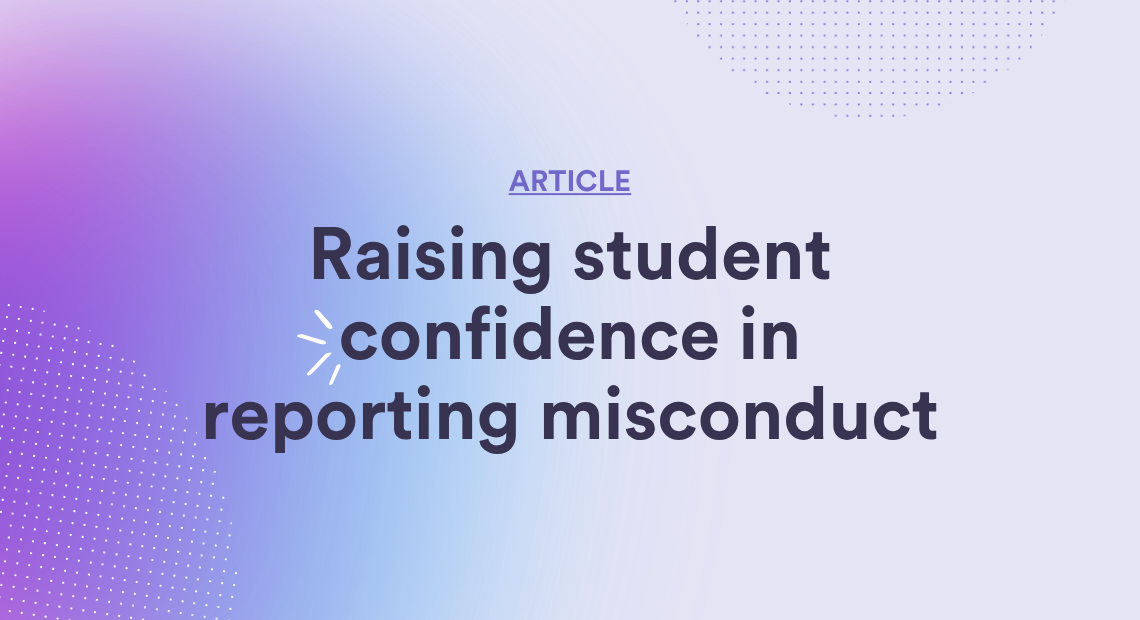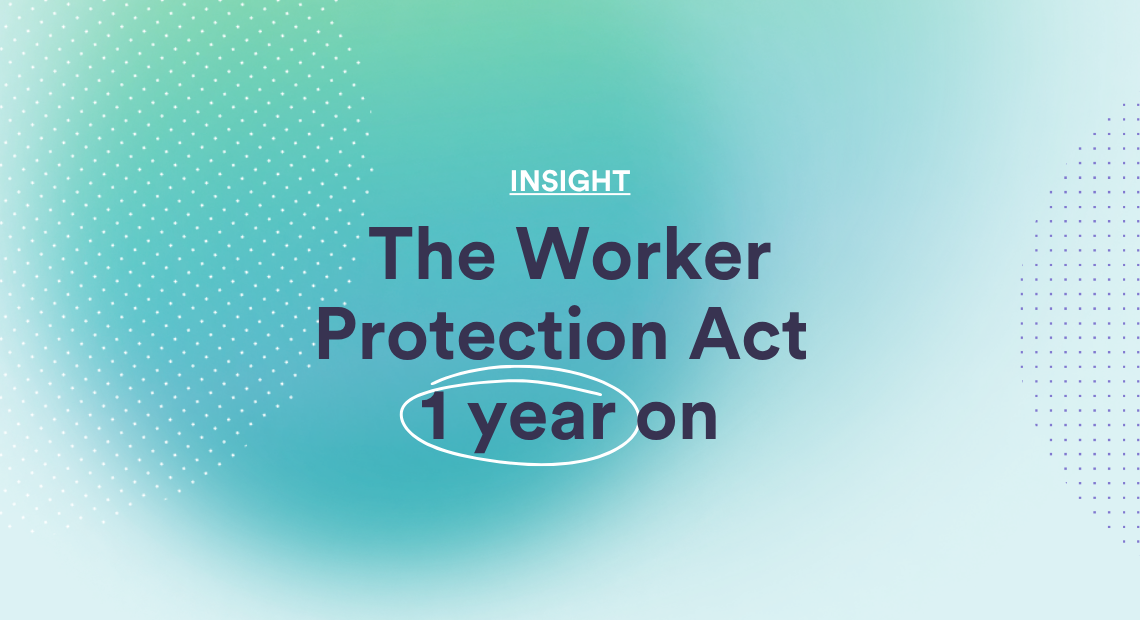Raising student confidence in reporting complaints of harassment and sexual misconduct on campus
Significant numbers of students are still experiencing harassment and sexual misconduct every year throughout their time at university. A 2022 study in the UK found that 20% of respondents experienced at least one act of attempted or forced sexual touching or rape, whilst 52% experienced at least one act of sexual harassment such as sexist remarks or jokes.
The research uncovered high numbers of women experiencing sexual violence, with most acts taking place at the university. Whilst the above statistics came from a study that was only conducted on one campus, the results are mirrored by the OFS pilot survey, which found 20% of students have experienced unwanted sexual behaviour, with nearly 70% of these occurring in a university setting or involving someone connected to the university.
The research does reveal that sexual harassment prevalence levels in higher education could be higher than originally thought, and therefore, raising student confidence in the reporting and handling of sexual harassment complaints is key to eliminating it on campus.
Whilst the higher education sector’s approach to tackling harassment and sexual misconduct has come a long way in the last decade, with many institutions taking a huge step forward in their response to sexual harassment, the statistics are clear; higher education institutions are still not doing enough to eliminate sexual harassment.
The introduction of the new OFS E6 regulation which took effect in August 2025 demonstrates a commitment to a more robust approach to tackling and eliminating sexual harassment across the sector, placing new duties on HE governance to provide a comprehensive, easily accessible single source of information outlining how students can report incidents, what constitutes unacceptable behaviour, and the support available, as well as demonstrating adequate capacity and resources to address harassment effectively.
Why don’t higher education students report harassment and sexual harassment?
Reasons students do not report harassment, and sexual harassment is a complex, multifaceted topic but mainly centres around fear. Usually there are a combination of factors for not disclosing harassment including fear that they will not be believed or taken seriously, fear of retaliation and the consequences of reporting. It also often includes discomfort about the reporting process, anxiety about damaging their reputation, being ostracised from their peers and even uncertainty about what behaviours constitute harassment or sexual harassment.
Often students just want to be able to continue with their studies without worrying about how they may be seen by others for reporting – we can all empathise with the desire to want to fit in and be accepted by our peers.
To read more on this topic click here
Ways for Higher Education Governance to raise student confidence when reporting sexual harassment
For the last seven years, Culture Shift’s Report + Support™ tool has helped universities improve disclosure rates of harassment and sexual harassment, providing universities with greater visibility about the types of behaviours taking place and being experienced by students. Whilst many of our Higher Education partners are doing a fantastic job at improving student confidence when it comes to reporting sexual harassment, more needs to be done to standardise responses across the sector and improve student confidence in reporting processes, investigations and outcomes of their report.
The Office of the Independent Adjudicator (OIA) who review student complaints, has also recently released several case studies in relation to the way universities dealt with complaints of harassment and sexual harassment by students.
Combined with our expertise and work in the Higher Education sector, along with the OIA case studies, it’s clear there are some common key issues providers are facing when addressing student complaints, with the most common complaint centring around how cases were handled and what happens after students make a report.
Review your feedback & reporting mechanisms
Clear and accessible reporting mechanisms are the first step to increasing student confidence in the reporting process. Students need to know how to report harassment or sexual harassment when they see or experience it, so the reporting mechanism should be properly signposted, ensuring it’s visible and at the forefront of students’ minds.
Consider at what points throughout your students’ university journey are they made aware of how to report and what to report – just because they were told about it during their induction doesn’t mean you should assume they know how to make a report. There’s a lot to take in at the start of university and in the excitement of a new experience, understanding how to report harassment and sexual harassment is unlikely to be something that everyone remembers. Engaging with your students’ union and ensuring campaigns are running across the university is crucial to increasing awareness of reporting mechanisms, keeping it front and centre mind, along with ensuring all academic staff know how to support students coming forward. Ensuring students and staff are sufficiently informed is part of the OfS regulatory compliance. Culture Shift’s campaigns can help you to promote your site all year round. You can also make use of our specific campaigns to address bystander interventions and allyship, as well as promote specific action and awareness dates to draw attention to specific behaviours.
Implementing an accessible reporting mechanism is critical for raising concerns; by streamlining the reporting process it makes it easy for students to report, without a long or complicated process. Having the confidence to come forward and report harassment or sexual harassment can be daunting, providers need to remove as many barriers as possible to the reporting process, making it straight forward and no longer than it needs to be.
If you already have a Report +Support platform in place, when was the last time you reviewed the questions asked or monitored your completion rates? If you’ve seen a drop in reports, what’s the reason for that? It’s easy to think because reports have dropped that behaviour is improving, and whilst we always hope that is the case, perhaps there’s an external factor impacting on students making a report. Seek feedback from students to ensure this isn’t the case.
Take reports seriously, non-judgmental, non-bias approach without prejudice
A common thread in the OIA cases centred around students feeling that their reports were not being taken seriously or that they felt pre-judged by the case manager.
Students raising reports complained that they felt they experienced ‘victim-blaming’ whilst students accused of harassment said they felt they had to ‘prove their innocence’. Whilst under investigation, universities have the same responsibility towards students reporting harassment and those accused of harassment and therefore should be treated without prejudice.
Students need to be confident that they will not be prejudged when they make a report, or that investigators have not ‘taken sides’ – this is fundamental to building trust in the reporting process and encouraging students to speak up when they see or experience harassment or sexual harassment.
Proper training for staff dealing with reports and conducting investigations
Staff dealing with reports, conducting investigations and carrying out the disciplinary process should receive proper training, particularly around how they interact with students, practising compassionate communication. With the proper training, students should hopefully feel less like they are being prejudged
Investigators and panels need a specific set of skills when conducting interviews and investigations, providing the right training is key to putting students at ease while establishing key facts. As we’ve already pointed out, it’s highly likely that students reporting incidents have had a distressing experience that may be difficult to speak about so investigators need to tread carefully to ensure the investigation process is as painless as possible.
Communication with students is key
Many of the OIA cases referred to poor communication from providers after students had made a report. To build confidence in reporting, it’s essential that you continually communicate with students throughout the case management process. Confirm that you have received the report and outline what the next steps are with estimated timescales, if possible.
At this point, it’s also vital to signpost students to the support available, whether that’s a referral to the specialist Sexual Harassment and Violence Support Service, services related to a specific protected characteristic, academic or generalist pastoral support.
Sometimes investigation processes can be long, particularly if the police are involved and therefore keeping in touch throughout is essential, even if it’s just a short update to say the process is still ongoing and when you hope to be able to let them know the next step or outcome.
At Culture Shift, we’ve launched a two-way messaging system in the Report + Support™ platform, which allows case workers to directly message both anonymous or named reporters to provide essential support.
A robust investigation and case management process
If your Higher Education institution is not using a Report + Support™ platform which centralises reporting and case management into one platform, dealing with reports can be a manual and time-consuming process, particularly ensuring reports are followed up properly. A common problem we hear about is how reports can slip through the gaps when there’s no centralised process.
If you are always reacting to reports with no clear process or procedure, it can lead to inconsistencies in how cases are dealt with and investigated, decreasing student confidence in the process.
Having a consistent approach to your case handling processes is necessary to ensure they are all dealt with to the same standard. A platform like Culture Shift’s Report + Support means that your case management is centralised, it’s easy to triage reports, prioritising by risk, whilst simple workflows allow your team to monitor and track case processes in real time. With a robust approach to case management, you can build trust with students.
Complex cases which contain distressing incidents can highlight how challenging it can be to conduct a thorough investigation. When there are delays to investigations or investigations are carried out inconsistently, it can lead to further distress for the student.
Outcomes and student support
We’ve already mentioned the importance of communicating with students throughout the reporting process and it should continue all the way through to the outcome of the report. You should provide students with a written outcome and summary of the disciplinary process (if appropriate). This can help bring closure to students and increase their confidence, knowing that their report has been taken seriously, properly investigated and what the provider has done to prevent it from happening again and to others.
Having said that, the OIA found that often the reporting process focuses too much on the disciplinary element and less on support for students reporting the misconduct. We shouldn’t forget that students have potentially experienced something distressing with long-lasting effects on their health and wellbeing and therefore signposting to the correct pastoral support is essential.
When communicating with students, case workers shouldn’t forget to ask them how they are doing and if there’s anything else they can do to support them. You may be surprised with how they respond and by taking an interest in their ongoing wellbeing can help to build trust and increase confidence in the process. If students felt like their report was handled without empathy, and they tell their peers, it could discourage others from coming forward.
Learning from and sharing outcomes
Lastly, reflecting on the outcomes of cases, analysing the data available to you and listening to student feedback will help Higher Education providers to monitor trends, provide targeted intervention and improve student experiences, helping to eliminate harassment and sexual harassment in a university setting. In the Culture Shift platform our insight report builder helps providers share data insights regularly and even allows you to build an annual report, highlighting specific data and actions that have been taken across the course of a year to help build student trust and confidence in the system.




